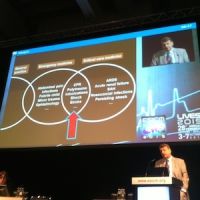The transition from a homegrown electronic health record to a commercially available EHR system affected emergency physician work activities, resulting in more tasks performed per minute (or an increase of nearly 12 percent), according to a new study in Annals of Emergency Medicine. Researchers say frequent task switching after the new EHR was implemented could lead to more stress and frustration, increasing the potential for patient safety hazards.
"Our study highlights the broader problem that commercial systems are often not adequately designed, from a usability perspective, to support the workflow processes of the clinician," senior study author Raj Ratwani, PhD, told ICU Management. "Our results may be one explanation for the dissatisfaction clinicians have with EHRs and for the increased frustration."
Dr. Ratwani, Scientific Director of the National Center for Human Factors in Healthcare at MedStar Health in Washington, D.C., and colleagues studied workflow for three periods: pre-implementation of the EHR, one week following widespread use of the EHR ("go-live") and 3 to 4 months after the EHR was implemented. Time spent on computer-based tasks increased from 31 minutes pre-implementation to 44 minutes in the go-live period. In addition, verbal communication decreased from 19 minutes pre-implementation to 11 minutes in the go-live period.
Although time spent on computer-based tasks eventually returned to pre-implementation levels, the increase in tasks performed per minute continued during long-term use of the commercial EHR. The number of tasks emergency physicians engaged in per minute increased from 1.7 tasks during the pre-implementation period to 1.9 tasks during post-implementation and stayed there.
"Our study underscores the need for a user-centred design approach that puts the needs of clinicians at the forefront of EHR design and development. This means engaging clinicians early and often during design, more rigorous user testing by the vendors prior to releasing these systems, as well as improved research by the healthcare system (in conjunction with the vendor) in discovering the best way to incorporate these systems into their current work practices," Dr. Ratwani pointed out.
He revealed that his team is currently conducting extensive research to improve the usability of health IT systems from a policy perspective as well as from the frontline clinician perspective. At the policy level, he said his group only recently had testified at the Senate HELP committee on EHR usability and published a paper in JAMAdescribing how many EHR vendors do not adhere to usability standards.
From a research perspective, he added, "we have a R01 grant from the Agency for Health Research in Quality entitled 'Cognitive Engineering for Complex Decision Making & Problem Solving in Acute Care'; we are focusing on work processes in the ED." The goal of this initiative is to iteratively design an ED information system that supports the unique decision-making needs of ED personnel, he explained. "Our aim is that findings and methods used in this study will inform future EHR design."
Claire Pillar, Managing Editor, ICU Management & HealthManagement.org
Source: American College of Emergency Physicians; Interview
Image credit: MedStar Institute for Innovation
"Our study highlights the broader problem that commercial systems are often not adequately designed, from a usability perspective, to support the workflow processes of the clinician," senior study author Raj Ratwani, PhD, told ICU Management. "Our results may be one explanation for the dissatisfaction clinicians have with EHRs and for the increased frustration."
Dr. Ratwani, Scientific Director of the National Center for Human Factors in Healthcare at MedStar Health in Washington, D.C., and colleagues studied workflow for three periods: pre-implementation of the EHR, one week following widespread use of the EHR ("go-live") and 3 to 4 months after the EHR was implemented. Time spent on computer-based tasks increased from 31 minutes pre-implementation to 44 minutes in the go-live period. In addition, verbal communication decreased from 19 minutes pre-implementation to 11 minutes in the go-live period.
Although time spent on computer-based tasks eventually returned to pre-implementation levels, the increase in tasks performed per minute continued during long-term use of the commercial EHR. The number of tasks emergency physicians engaged in per minute increased from 1.7 tasks during the pre-implementation period to 1.9 tasks during post-implementation and stayed there.
"Our study underscores the need for a user-centred design approach that puts the needs of clinicians at the forefront of EHR design and development. This means engaging clinicians early and often during design, more rigorous user testing by the vendors prior to releasing these systems, as well as improved research by the healthcare system (in conjunction with the vendor) in discovering the best way to incorporate these systems into their current work practices," Dr. Ratwani pointed out.
He revealed that his team is currently conducting extensive research to improve the usability of health IT systems from a policy perspective as well as from the frontline clinician perspective. At the policy level, he said his group only recently had testified at the Senate HELP committee on EHR usability and published a paper in JAMAdescribing how many EHR vendors do not adhere to usability standards.
From a research perspective, he added, "we have a R01 grant from the Agency for Health Research in Quality entitled 'Cognitive Engineering for Complex Decision Making & Problem Solving in Acute Care'; we are focusing on work processes in the ED." The goal of this initiative is to iteratively design an ED information system that supports the unique decision-making needs of ED personnel, he explained. "Our aim is that findings and methods used in this study will inform future EHR design."
Claire Pillar, Managing Editor, ICU Management & HealthManagement.org
Source: American College of Emergency Physicians; Interview
Image credit: MedStar Institute for Innovation
References:
Ratwani RM et al. (2015) Emergency Physician Task Switching Increases With the Introduction of a Commercial Electronic Health Record. Annals
of Emergency Medicine, September 18, 2015. DOI:
http://dx.doi.org/10.1016/j.annemergmed.2015.07.514
Latest Articles
healthmanagement, emergency medicine, health IT, ER, electronic health record, usability, patient safety
The transition from a homegrown electronic health record to a commercially available EHR system affected emergency physician work activities, resulting in more tasks performed per minute by nearly 12 percent, according to a new study in Annals of Emergenc



























